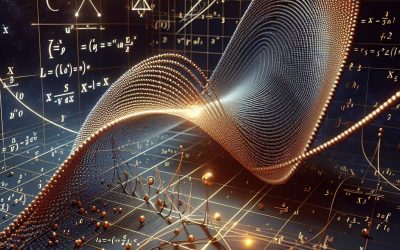➕ Introduction to Mathematics
The Language of Patterns, Logic, and Problem-Solving
Mathematics is the science of numbers, shapes, patterns, and relationships. It provides a universal language to describe the world around us—whether we’re counting, measuring, predicting, or solving complex problems. More than just calculations, maths is a way of thinking: logical, precise, and creative.
At its core, mathematics explores questions like:
-
How do we measure and compare things?
-
What happens when we follow certain rules or operations?
-
How can we predict outcomes or analyse patterns?
-
What structures exist beneath the surface of reality?
Maths is used in every area of life—from calculating a grocery bill to designing bridges, forecasting the weather, or sending spacecraft to Mars. It’s essential in science, engineering, technology, economics, architecture, and even music and art.
Divided into fields such as arithmetic, algebra, geometry, statistics, and calculus, mathematics grows more powerful as we explore deeper concepts. And it’s not just about finding the right answer—it’s about understanding why it’s right, and discovering new ways to think.
Studying maths sharpens our ability to reason, solve problems, and recognise the hidden patterns that shape our world.
Unlocking the Secrets of Modular Arithmetic: A Beginner’s Guide to Solving Complex Equations
Modular arithmetic is a branch of mathematics that deals with the remainder when one number is divided by another. It is a fundamental concept in number theory and has applications in various fields such as cryptography, computer science, and physics. In modular arithmetic, numbers “wrap around” after reaching a certain value called the modulus. The history of modular arithmetic can be traced back to ancient civilizations such as the Egyptians and Babylonians, who used modular arithmetic to solve problems related to timekeeping and calendar systems. However, the formal development of modular arithmetic as a mathematical discipline can be attributed to Carl Friedrich Gauss in the late 18th century. Gauss introduced the concept of congruence, which forms the basis of modular arithmetic. Key Takeaways Modular arithmetic is a type of arithmetic that deals with remainders. It is useful in solving equations and cryptography. Modular arithmetic has applications in computer science and number theory. Advanced techniques can be used to solve complex equations. Real-world examples of modular arithmetic include credit card validation and internet security. Understanding the Basics of Modular Arithmetic In modular arithmetic, there are four basic operations: addition, subtraction, multiplication, and division. These operations are performed on the remainders obtained when numbers are divided by a modulus. For example, in modulo 7 arithmetic, 3 + 5 = 1 because the remainder of 3 divided by 7 is 3 and the remainder of 5 divided by 7 is 5, and their sum is 8 which has a remainder of 1 when divided by 7. Modular arithmetic also has several properties that make it unique. These properties include reflexivity (a ≡...
Mastering Divisibility: Unlocking the Secrets of Numbers
Divisibility is a fundamental concept in mathematics that deals with the ability of one number to be divided evenly by another number. In simple terms, a number is divisible by another number if it can be divided into equal parts without leaving a remainder. For example, 10 is divisible by 2 because it can be divided into two equal parts, resulting in 5. Divisibility plays a crucial role in various mathematical operations and is essential for understanding more complex mathematical concepts. Understanding the basics of divisibility is important because it forms the foundation for many mathematical concepts and operations. Divisibility is used in various branches of mathematics, such as algebra, geometry, and number theory. It allows mathematicians to analyze numbers and identify patterns and relationships between them. Divisibility also helps in simplifying calculations and solving equations. To understand divisibility, it is important to grasp some basic concepts. One such concept is the idea of factors. A factor of a number is a whole number that divides evenly into that number without leaving a remainder. For example, the factors of 12 are 1, 2, 3, 4, 6, and 12. Another concept related to divisibility is multiples. A multiple of a number is the result of multiplying that number by any whole number. For example, the multiples of 3 are 3, 6, 9, 12, and so on. Key Takeaways Divisibility is the ability of a number to be divided by another number without leaving a remainder. Divisibility rules are shortcuts that help determine if a number is divisible by another number. Prime numbers are numbers that are only divisible by 1...
Unlocking the Magic of Prime Numbers: The Fascinating World of Mathematics
Prime numbers are a fundamental concept in mathematics. They are defined as positive integers greater than 1 that have no divisors other than 1 and themselves. In other words, prime numbers cannot be divided evenly by any other number except for 1 and the number itself. Prime numbers play a crucial role in various areas of mathematics, including number theory, cryptography, and computer science. They are considered the building blocks of mathematics because all other numbers can be constructed from prime numbers through a process called prime factorization. Some examples of prime numbers include 2, 3, 5, 7, 11, and 13. These numbers cannot be divided evenly by any other number except for 1 and themselves. Prime numbers become less frequent as we move along the number line, with larger prime numbers becoming increasingly rare. Key Takeaways Prime numbers are the fundamental building blocks of mathematics. The history of prime numbers dates back to ancient times and continues to be an active area of research today. Prime number patterns and factorization reveal the secrets of primes and their unique properties. The Sieve of Eratosthenes is a simple and effective method for finding prime numbers. Prime numbers have important applications in cryptography, number theory, and beyond. The History of Prime Numbers: From Ancient Times to Modern Research The study of prime numbers dates back to ancient civilizations such as the Egyptians and the Greeks. The Egyptians were among the first to recognize the significance of prime numbers in their mathematical system. They used prime numbers in their calendar system and for measuring land. In ancient Greece, mathematicians like Euclid made...
The Fascinating World of Number Theory: Unraveling the Mysteries of Prime Numbers and More
Number theory is a branch of mathematics that deals with the properties and relationships of numbers, particularly integers. It is one of the oldest and most fundamental areas of mathematics, with roots dating back to ancient civilizations such as the Egyptians and Babylonians. Number theory has applications in various fields, including cryptography, computer science, and physics. It provides a foundation for many other branches of mathematics and is essential for understanding the structure and behavior of numbers. Key Takeaways Number theory is the study of the properties of numbers and their relationships. Prime numbers are fascinating because they can only be divided by 1 and themselves. The Sieve of Eratosthenes is a simple method to find prime numbers by eliminating multiples of smaller primes. Goldbach’s Conjecture states that every even number can be expressed as the sum of two prime numbers. The Riemann Hypothesis is a famous unsolved problem in mathematics that deals with the distribution of prime numbers. The Beauty of Prime Numbers Prime numbers are a central concept in number theory. A prime number is a positive integer greater than 1 that has no positive divisors other than 1 and itself. In other words, it cannot be divided evenly by any other number except for 1 and itself. For example, 2, 3, 5, 7, and 11 are all prime numbers. Prime numbers have several interesting properties. One property is that every positive integer greater than 1 can be expressed as a unique product of prime numbers, known as its prime factorization. This property is fundamental to many areas of mathematics, including algebra and number theory. Prime numbers...
Uncovering Insights with Regression Analysis: A Comprehensive Guide
Regression analysis is a statistical technique used to model the relationship between a dependent variable and one or more independent variables. It is a powerful tool for understanding and predicting the behavior of variables in various fields, including economics, finance, social sciences, and healthcare. The main purpose of regression analysis is to estimate the parameters of a mathematical equation that best describes the relationship between the variables. In regression analysis, the dependent variable is also known as the outcome variable or response variable, while the independent variables are referred to as predictors or explanatory variables. The goal is to find the best-fitting line or curve that represents the relationship between the predictors and the outcome variable. This line or curve can then be used to make predictions or understand the impact of changes in the predictors on the outcome variable. Key concepts and terminology in regression analysis include: – Regression equation: The mathematical equation that represents the relationship between the predictors and the outcome variable.– Coefficients: The values that represent the slope or impact of each predictor on the outcome variable.– Residuals: The differences between the observed values of the outcome variable and the predicted values from the regression equation.– Assumptions: The conditions that must be met for regression analysis to be valid, such as linearity, independence, and normality of residuals. Key Takeaways Regression analysis is a statistical method used to model the relationship between a dependent variable and one or more independent variables. Linear, multiple, and nonlinear regression are the three main types of regression models used in data analysis. Data preparation is a crucial step in regression...
Unlocking the Power of Statistical Tests: How to Make Data-Driven Decisions
Statistical tests are a crucial component of data analysis. They are used to determine whether there is a significant difference or relationship between variables in a dataset. Statistical tests provide a way to make objective and evidence-based conclusions from data, helping researchers and analysts draw meaningful insights. In simple terms, statistical tests involve comparing observed data to what would be expected by chance alone. By doing so, they help determine whether the observed results are statistically significant or if they could have occurred by random chance. This allows researchers to make inferences about the population from which the data was collected. Statistical tests are important because they provide a rigorous and systematic approach to analyzing data. They help researchers make informed decisions, draw valid conclusions, and avoid making false claims based on anecdotal evidence or personal biases. Statistical tests also allow for the replication of research findings, as they provide a standardized method for analyzing data that can be used by other researchers in the field. Key Takeaways Statistical tests are important tools for analyzing data and making informed decisions. There are different types of statistical tests, each with its own purpose and appropriate use. Hypothesis testing is a key component of statistical analysis, allowing us to draw conclusions about data. Choosing the right statistical test for your data requires careful consideration of variables and research questions. Conducting statistical tests involves following a step-by-step process and interpreting results accurately. Understanding the Different Types of Statistical Tests and When to Use Them There are various types of statistical tests, each designed for different types of data and research questions. Two...
Exploring the Fascinating World of Probability Distributions: Understanding the Basics and Applications
Probability distributions are a fundamental concept in statistics and data science. They provide a way to describe the likelihood of different outcomes or events occurring in a given situation. In simple terms, a probability distribution is a mathematical function that assigns probabilities to different outcomes of a random variable. Probability distributions play a crucial role in statistics and data science because they allow us to make predictions and draw conclusions based on data. By understanding the underlying probability distribution of a dataset, we can analyze and interpret the data more effectively. Probability distributions also provide a framework for making decisions under uncertainty and assessing risk. To understand probability distributions, it is important to be familiar with some basic concepts and terminology. A random variable is a variable whose value is determined by chance or randomness. It can take on different values, each with a certain probability. The set of all possible values that a random variable can take is called the sample space. The probability of each value in the sample space is given by the probability distribution. Key Takeaways Probability distributions are mathematical functions that describe the likelihood of different outcomes in a random event. There are two types of probability distributions: discrete and continuous. The probability density function (PDF) and cumulative distribution function (CDF) are important tools for understanding probability distributions. Common probability distributions include the normal, Poisson, binomial, and Bernoulli distributions. Probability distributions have many real-life applications, including in finance, engineering, and healthcare. Types of Probability Distributions: Discrete and Continuous There are two main types of probability distributions: discrete and continuous. Discrete probability distributions are used...
Crunching the Numbers: Understanding Mean, Median, and Mode in Statistics
In statistics, central tendency refers to the measure that represents the center or typical value of a dataset. It provides a summary of the data by identifying a single value that best represents the entire dataset. The three most commonly used measures of central tendency are mean, median, and mode. The mean, also known as the arithmetic average, is calculated by summing up all the values in a dataset and dividing it by the total number of values. It is widely used in statistics because it takes into account every value in the dataset and provides a balanced representation of the data. Key Takeaways Mean, median, and mode are measures of central tendency used to describe a set of data. Mean is the arithmetic average of a set of numbers, calculated by adding them up and dividing by the total number of values. Median is the middle value in a set of numbers when they are arranged in order, and is not affected by extreme values. Mode is the most frequent value in a set of numbers, and can be used for categorical data as well as numerical data. Mean, median, and mode can be used to compare different sets of data, but it is important to consider the context and distribution of the data. Calculating Mean: The Arithmetic Average The formula for calculating the mean is: Mean = (Sum of all values) / (Total number of values) For example, let’s say we have a dataset of test scores: 80, 85, 90, 95, and 100. To calculate the mean, we add up all the values (80 + 85 +...
Unveiling the Power of Statistics and Probability: A Comprehensive Guide to Data Analysis
Statistics and probability are two branches of mathematics that play a crucial role in various fields, including science, business, economics, social sciences, and more. Statistics is the study of collecting, analyzing, interpreting, presenting, and organizing data. It involves the use of mathematical techniques to summarize and describe data, make inferences and predictions, and test hypotheses. Probability, on the other hand, is the study of uncertainty and the likelihood of events occurring. It provides a framework for quantifying uncertainty and making informed decisions based on available information. The importance of statistics and probability cannot be overstated. In today’s data-driven world, these disciplines are essential for making informed decisions and solving complex problems. They help us understand patterns and trends in data, identify relationships between variables, make predictions about future outcomes, and evaluate the effectiveness of interventions or treatments. From healthcare to finance to marketing, statistics and probability are used to analyze data, make predictions, and inform decision-making processes. To understand statistics and probability, it is important to be familiar with some basic concepts and terminologies. In statistics, data refers to any information that is collected or observed. It can be numerical or categorical. Numerical data can be further classified as discrete or continuous. Discrete data consists of whole numbers or counts (e.g., number of students in a class), while continuous data can take any value within a range (e.g., height or weight). Categorical data, on the other hand, consists of categories or labels (e.g., gender or occupation). Key Takeaways Statistics and probability are important tools for analyzing and interpreting data. Understanding data types and variables is crucial for accurate analysis....
Solving Real-World Problems with Differential Equations: A Beginner’s Guide
Differential equations are mathematical equations that involve derivatives. They describe the relationship between a function and its derivatives, and are used to model a wide range of phenomena in science and technology. A differential equation can be thought of as an equation that relates the rate of change of a quantity to the quantity itself. Differential equations are of great importance in various fields of science and technology. They are used to model physical systems, such as the motion of objects, the flow of fluids, and the behavior of electrical circuits. In engineering, differential equations are used to design and analyze systems, such as control systems and signal processing systems. In biology, differential equations are used to model population dynamics, the spread of diseases, and the behavior of biochemical reactions. Key Takeaways Differential equations are mathematical equations that describe how a quantity changes over time or space. Differential equations can be classified based on their order, linearity, and homogeneity. First-order differential equations can be solved using separable, linear, and exact methods. Second-order differential equations can be homogeneous or nonhomogeneous, and can be solved using various techniques. Differential equations have numerous applications in fields such as population growth, chemical reactions, and electrical circuits, and are important for modeling real-world problems in physics, engineering, and biology. Basic Concepts of Differential Equations: Order, Linearity, and Homogeneity In differential equations, the order refers to the highest derivative that appears in the equation. For example, a first-order differential equation involves only first derivatives, while a second-order differential equation involves second derivatives. The order of a differential equation determines the number of initial or boundary...
Mastering Integrals: The Key to Unlocking Advanced Calculus
Integrals are a fundamental concept in calculus that allow us to find the total accumulation of a quantity over a given interval. They are an essential tool for solving a wide range of problems in mathematics, physics, engineering, and other fields. Integrals provide us with a way to calculate areas, volumes, and even the behavior of complex functions. Without integrals, many of the advancements we have made in these fields would not be possible. Key Takeaways Integrals are a fundamental concept in calculus that involve finding the area under a curve. Integrals are important in calculus because they allow us to find the total change in a function over a given interval. Common techniques for solving integrals include substitution, integration by parts, and trigonometric substitution. Integrals can be used to find areas and volumes of irregular shapes in geometry and physics. Advanced integration methods, such as partial fractions and Laplace transforms, are used to solve complex functions in engineering and physics. Understanding the Basics of Integrals An integral is a mathematical concept that represents the area under a curve. It is denoted by the symbol ∫ and is used to find the total accumulation of a quantity over a given interval. There are two types of integrals: definite and indefinite. A definite integral has specific limits of integration and gives us a numerical value. An indefinite integral does not have limits of integration and gives us a general function. The fundamental theorem of calculus is a key concept in understanding integrals. It states that if a function f(x) is continuous on an interval [a, b] and F(x) is an...
Exploring the World of Derivatives: Understanding the Basics and Potential Benefits
Derivatives are financial instruments that derive their value from an underlying asset or benchmark. They can be used for various purposes, such as hedging against price fluctuations, speculating on future price movements, or leveraging investment positions. Derivatives can be based on a wide range of assets, including stocks, bonds, commodities, currencies, and interest rates. There are several types of derivatives, including futures contracts, options contracts, swaps, and forwards. Futures contracts are agreements to buy or sell an asset at a predetermined price and date in the future. Options contracts give the holder the right, but not the obligation, to buy or sell an asset at a specified price within a certain time period. Swaps involve the exchange of cash flows between two parties based on predetermined terms. Forwards are similar to futures contracts but are typically customized and traded over-the-counter. Derivatives work by allowing investors to take positions on the future price movements of an underlying asset without actually owning the asset itself. This provides investors with opportunities to profit from both rising and falling markets. For example, if an investor believes that the price of a particular stock will increase in the future, they can buy a call option on that stock. If the stock price does indeed rise, the investor can exercise the option and buy the stock at a lower price than the market value. On the other hand, if the stock price falls, the investor can simply let the option expire and limit their losses to the premium paid for the option. Key Takeaways Derivatives are financial instruments that derive their value from an underlying...














